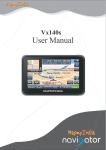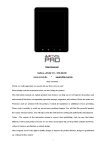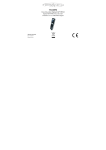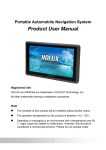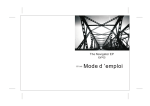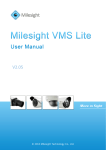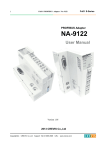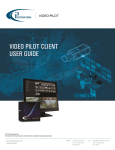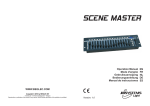Download Arrival NAV-PNF 43 User manual
Transcript
User manual Hardware NAV-PNF 35 Hotline +49 (0) 511 / 123 83 506 www.a-rival.de * [email protected] 1 Precautions and Notices . For your own safety, do not operate the controls of the product while driving. . Use this product prudently. The product is intended to be used only as a navigation aid. It is not for precise measurement of direction, distance, location or topography. . The calculated route is for reference only. It is the user's responsibility to follow the traffic signs and local regulations along the roads. . When you get off the car, do not leave your device on the dashboard that is subject to direct sunlight. The overheating of the battery can cause malfunction and/or danger. . GPS is operated by the United States government, which is solely responsible for the performance of GPS. Any change to the GPS system can affect the accuracy of all GPS equipments. . GPS satellite signals cannot pass through solid materials (except glass). When you are inside a tunnel or building, GPS positioning is not available. . A minimum of 4 GPS satellite signals is needed to determine current GPS position. Signal reception can be affected by situations such as bad weather or dense overhead obstacles (e.g. trees and tall buildings). . Other wireless devices in the vehicle might interfere with the reception of satellite signals and cause the reception to be unstable. . A car holder is needed when using the device in a car. Be sure to place the device in an appropriate place, so as not to obstruct the driver's view or deployment of air bags. 2 Table of Contents Precautions and Notices................................................................................2 1Getting Started.............................................................................................5 1.1 Understanding Hardware Features..........................................................5 Front and back components...........................................................................5 Top components.............................................................................................6 Side components............................................................................................6 1.2 Connecting to AC Power and Charging the Battery (Optional)..................7 1.3 Using the TMC module (Optional).................................................................8 1.4 Using the Car Holder...................................................................................8 1.5 Connecting the Car Charger.....................................................................8 2 Operating Basics.......................................................................................9 2.1 Performing the Initial Start Up...................................................................9 2.2 Turning On and Off/sleeping mode...........................................................9 2.3 Operating the Device................................................................................10 2.4 Main Menu..............................................................................................11 2.5 Inserting a microSD Card.......................................................................11 3 Device Settings.......................................................................................13 3.1 Using Device Settings............................................................................13 3.2 Volume...................................................................................................13 3.3 Date/time...............................................................................................14 3.3.1 Time zone.................................................................................................14 3.4 Backlight................................................................................................14 3.5 Language...............................................................................................15 3.6 calibrator................................................................................................15 3.7 about......................................................................................................16 4.1 GPS Receiver......................................................................................16 5 Trouble shooting and maintenance...........................................................17 5.1 Resetting Your System..............................................................................17 5.2 Troubleshooting.........................................................................................17 Screen freezes......................................................................................18 GPS Problems......................................................................................19 5.3 Maintaining Your Device ...........................................................................20 6 Regulatory Information ......................................................................21 6.1 Regulations Statements .........................................................................21 Canada.................................................................................................21 3 7 Safety ......................................................................................................23 7.1 Safety Precautions .................................................................................23 About the Battery .................................................................................24 8 Main Elements.........................................................................................25 4 Getting Started 1.1 Understanding Hardware Features NOTE: Depending upon the specific model purchased, the color of your device exactly match the device shown in this manual. Front Components 1 Ref 1 Component Touch Screen Description Displays the output of your device. Tap the Screen with your fingertip to select menu commands or enter information. Back Components 1 2 Ref 1 2 Component Speaker Reset Button Description Sends out music, sounds and voice. Restart system. 5 Top Components 2 1 Bottom Components 3 Ref Component Description 1 ON/OFF Switch The main power/battery cut off switch. 2 Charge Indicator 3 Mini-USB Connector Glows bright amber to indicate that the battery is charging, and turns green when the battery is fully charged. Connects to the USB cable. Side Components 1 2 Ref Component Description 1 microSD Slot Accepts a microSD (Secure Digital) card for accessing data such as Music. 2 Headphone Connector Connects to stereo headphones. 6 Getting Started 1.2 Connecting to AC Power and Charging the Battery (Optional) When charging the battery for the first time, you should charge it for at least 8 hours. 1. Slide and click the connector converter onto the AC adapter. 2. Connect the adapter cable to the bottom of your device. 3. Plug the AC adapter into a wall outlet. The charge indicator glows red when charging is in progress. Do not disconnect your device from AC power until the battery is fully charged, when the charge indicator turns amber. This will take a couple of hours. NOTE: . Do not immediately turn on your device after connecting the AC adapter to charge a power-depleted battery. If you need to turn on the device again, wait for at least one minute. . Depending on your region of purchase, the connector converter may not look exactly the same as the picture shown. . Your device can also be charged when it is connected to a desktop computer via the USB cable. CAUTION: For optimal performance of the lithium battery, take note of the following: . Do not charge the battery where the temperature is high (e.g. in direct sunlight). . There is no need to fully discharge the battery before charging. You can charge the battery before it is discharged. . If you will not use the product for a long period of time, be sure to fully charge the battery at least once every two weeks. Over discharge of the battery can affect the charging performance. 7 1.3 Using the TMC module(optional) (see the first picture) - Make sure, the TMC module is connected with the car-charger. The cable of the TMC module ,must be connected with your navigation-device. (see the 2nd picture) - The TMC module is connected between the navigation-device and the suction-mount. 1.4 Using the Car Holder CAUTION: . Select an appropriate location for the car holder. Never place the holder where the driver's field of vision is blocked. . If the car's windshield is tinted with a reflective coating, an external antenna (optional) may be needed to route the antenna to the top of the car through a window. When closing the car window, be careful not to pinch the antenna cable. (Cars with an anti-jam window design may automatically leave adequate space as needed.) The car holder consists of a bracket and a stand. Use the car holder to fix your device in a vehicle. Make sure that the GPS antenna has a clear view of the sky. (See the document supplied with the car holder for the installation instruction.) For initial positioning, remain at the same spot with a clear view of the sky. The GPS may take a few minutes to find its current location initially. NOTE: Depending upon the specific model purchased, the car holder supplied with your device may not look exactly the same as the picture shown. 1.5 Connecting the Car Charger The car charger supplies power to your device when you are using the device in a car. 8 CAUTION: To protect your device against sudden surges in current, connect the car charger only after the car engine has been started. 1. Connect one end of the car charger to the power connector of your device. 2. Connect the other end to the cigarette lighter in the car to power and charge your device. The indicator on the car charger lights in green to indicate that power is being supplied to your device. Operating Basics 2.1 Performing the Initial Start Up 1. Press the ON/OFF button for several seconds. ON/OF 2. Your device will automatically turn on. Connect the car charger as described in the next section. 3. The Opening screen appears. 4. The Main Menu appears as shown below. You can now use your device. 9 5. Fully charge the battery before using your device for the first time. 2.2 Turning On and Off / sleeping mode 1. Use the ON/OFF button to turn on and off your device. 2. If want to turn off the device, press the ON/OFF button for several seconds. Your device will appearing the menu of turning off. press button, the device is turned off. 3. If pressing button, the device will enter into sleeping state. When you press the button to turn off the unit, your device actually enters a suspend state and the system stops operating. Once you turn on the system again, it resumes. 2.3 Operating the Device To communicate with your device, touch the screen with your fingertip. You can perform the following actions: . Tap Touch the screen once with your fingertip to open item or options. . Drag Hold your fingertip on the screen and drag up/down/left/right or across the screen. . Tap and hold Tap and hold your fingertip until an action is complete, or a result or menu is shown. 10 Operating Basics 2.4 Main Menu The first time you initialize your device, the Main Menu appears. The Main Menu is your starting place for various tasks. Tap a button to start a task or open other menu. 2 1 Such as tap "Settings" button, enter into the submenu. Ref Button Name Description 1 Navigation Start navigation 2 Settings Device Settings For Detailed Information 2.5 Inserting a microSD Card Your device has a microSD slot where you can insert an optional Secure Digital storage card. To use a microSD card, insert it into the slot, with the connector pointing to the slot and its label facing the front of the device. 11 To remove a card, first make sure that no application is accessing the card, then slightly push the top edge of the card to release it and pull it out of the slot. NOTE: . Make sure that no foreign objects enter the slot. . Keep a microSD card in a well-protected box to avoid dust and humidity when you are not using it. 12 Devices settings 3.1 Using Device Settings To open the Device Settings menu, first tap the Settings button on the main menu. The Device Settings menu appears as shown above. The following sections describe these buttons and their functions. You can customize the device settings such as backlight, volume, date and time. Once you change the settings, your new settings will remain until you change them again. 3.2 Volume 1. Tap 2. Tap the knob volume, tap the knob 3. Tap the 4. Tap the button on the Device Settings menu. The volume function menu appears as shown below. and to adjust the volume. To decrease the . To increase the volume, tap the knob button to accomplish modification. button to quit modification to go back to the Device Settings screen. 13 . 3.3 Date/Time 1. Tap button on the Device Settings menu. The Date/Time Function menu appears as shown below. 2. Tap the item of needing to modify, through clicking and on the calendar, accomplish easily to adjustment ,such as: year, month and day. 3. Uniformity, clicking and on the calendar, you can accomplish easily to adjustment of hour, minute and second. 4. Tap the menu. button to save the changes and go back to the previous 3.3.1 Time zone To set the time in your Time zone correctly, tap the Time zone button on the bottom. Your Time zone is pre-set for Germany (GMT +1, see picture below). Confirm your setting by pressing the OK button. You are returned to the prior menu now. Winter/Summer time setting will be automatically changed. 3.4 Backlight 1. Tap button on the Device Settings menu. The backlight 14 Devices settings Function menu appears as shown below. 2. Tap the knob to adjust the backlight. To decrease the backlight, tap To increase the backlight, tap . 3.5 Language 1. Tap . button on the Device Settings menu. The Language Function menu appears as shown below. 2. Tap the knob and to select language. 3. After accomplishing, tap the knob to exit. 3.6 Calibrate You can calibrate the touch screen if it is not responding accurately to your Taps. 1. Tap “calibrate” button on the Device Settings menu. The calibrate Function menu appears as shown left-below . 15 2. Tap and hold the centre of the target, the target moves to the position of left-up. When again tap and hold the centre of the target, the target moves the Next position of left-down. 3. The target moves to five position (Left-up' left-down' right-up' right-down' Center) in order, forming a period. If nicetily tap and hold the target each time, after a period, the target is Disappear, the device completes the calibration process and backs to the Device Settings menu. 3.7 About 1. Tap button on the Device Settings menu. The About Function menu appears as shown right-up. 2. After accomplishing, tap the knob to exit. 4.1 GPS Receiver NOTE: This page is for information only. You can view the number of satellite signals the unit is receiving and also the strength of these signals. 1. Tap “GPS Receiver” button on the the Device Settings menu. 2. The GPS Receiver Function menu appears as shown below. This page gives your current position in degrees longitude and latitude, your current speed and the status of your position, i.e. Fixed 3D or Fixed Invalid etc. The compass circle shows the satellites that the unit is receiving and the bar chart below shows the strength of the signal from each of these satellites. 16 Troubleshooting and maintenance This chapter gives solutions to common problems you may encounter. It also provides guidelines on taking care of your device. NOTE: if you encounter a problem you can not solve, contact an authorized service center for assistance. 5.1 Resetting Your System Occasionally, you may need to reset your device. For example, you should reset your system when it stops responding; or appears to be "frozen" or " locked up" . Insert a small rod, such as a straightened paperclip, into the reset button on the bottom of your device. This is called a "soft reset." The Main Menu should appear after a soft reset. RESET If your device still does not respond after a soft reset, you can use the following steps to perform a "hard reset." 1. Disconnect all cables, including the AC adapter, from your device. 2. Press the ON/OFF button to the OFF position. 3. Wait for l minute and then press the button back to the ON position. ON/OF 4. Your device turns on. 5.2 Troubleshooting Power Problems Power does not turn on when using battery power The remaining battery power may be too low to run your device. Connect the AC adapter to your device and to AC power. Then, turn on your device. 17 Screen Problems Screen is off . If the screen does not respond even after you press the power button, try the following in order until the problem is solved. . Connect the AC adapter to your device and to external AC power. . Reset your system. Screen responds slowly . Make sure that your device is not running out of battery power. If the problem still exists, reset your system. Screen freezes . Reset your system. Screen is hard to read . Make sure that the backlight of the display is on. . Move to a location with more light. Inaccurate response to taps . Recalibrate the touch screen. (See section 3.4 for instructions.) Connection Problems Cable Connection Problems . Make sure that your device and your computer are both turned on before trying to establish a connection. . Make sure that the cable is securely plugged into the USB port on your computer and on the device. Connect the USB cable directly to your computer do not run the cable through a USB hub. . Reset your device before connecting the cable. Always disconnect your device before you restart your computer. 18 Troubleshooting and maintenance GPS Problems When there are no valid signals available, consider the following: . Make sure that the GPS antenna has a clear view of the sky. . Note that the GPS reception can be affected by: √Bad weather √Dense overhead obstacles (e.g. trees and tall buildings) √Other wireless device in the car √Reflective car window tint 19 5.3 Maintaining Your Device Taking good care of your device will ensure trouble-free operation and reduce the risk of damage to your device. . Keep your device away from excessive moisture and extreme temperatures. . Avoid exposing your device to direct sunlight or strong ultraviolet light for extended periods of time. . Do not place anything on top of your device or drop objects on your device. . Do not drop your device or subject it to severe shock. . Do not subject your device to sudden and severe temperature changes. this could cause moisture condensation inside the unit, which could damage your device. In the event of moisture condensation, allow the device to dry out completely before use. . Take care not to sit on the device. We advise not to carry the device in one's back pocket for that reason. . The screen surface can easily be scratched. Avoid touching it with sharp objects. Non-adhesive generic screen protectors designed specifically for use on portable devices with LCD panels may be used to help protect the screen from minor scratches. . Never clean your device with it powered on. Use a soft, lint-free cloth moistened with water to wipe the screen and the exterior of your device. . Do not use paper towels to clean the screen. . Never attempt to disassemble, repair or make any modifications to your device. Disassembly, modification or any attempt at repair could cause damage to your device and even bodily injury or property damage and will void any warranty. . Do not store or carry flammable liquids, gases or explosive materials in the same compartment as your device, its parts or accessories. 20 Regulatory information NOTE: Marking labels located on the exterior of your device indicate the regulations that your model complies with. Please check the marking labels on your device and refer to the corresponding statements in this chapter. Some notices apply to specific models only. 6.1 Regulations Statements Class B Regulations USA Federal Communications Commission Radio Frequency Interference Statement NOTE: This equipment has been tested and found to comply with the limits for a Class B digital device pursuant to Part 15 of the FCC Rules. These limits are designed to provide reasonable protection against harmful interference in a residential in stallation. This equipment generates, uses, and can radiate radio frequency energy and, if not installed and used in accordance with the instructions, may cause harmful interference to radio communications. However, there is no guarantee that interference will not occur in a particular installation. If this equipment does cause harmful interference to radio or television reception, which can be determined by turning the equipment off and on, the user is encouraged to try to correct the interference by one or more of the following measures: . Reorient or relocate the receiving antenna. . Increase the separation between the equipment and receiver. . Connect the equipment into an outlet on a circuit different from that to which the receiver is connected. . Consult the dealer or an experienced radio/TV technician for help. Any changes or modifications not expressly approved by the manufacturer could void the user's authority to operate the equipment. Please note: The use of a non-shielded interface cable with this equipment is prohibited. Canada Canadian Department Of Communications 21 Radio Interference Regulations Class B Compliance Notice This Class B digital apparatus meets all requirements of the Canada Interference-Causing equipment regulations. Cet appareil numérique de Classe B respecte toutes lesexigences duRèglement Canadien sur le matériel brouileur. European Notice Products with the CE marking comply with Radio & Telecommunication Terminal Equipment Directive (R&TTE) (1999/5/EEC), the Electromagnetic Compatibility Directive (89/336/EEC) and the Low Voltage Directive (73/23/EEC) as amended by Directive 93/68/ECC - issued by the Commission of the European Community. Compliance with these directives implies conformity to the following European Standards: EN301489-1: Electronic compatibility and Radio spectrum Matters (ERM), ElectroMagnetic Compatibility (EMC) standard for radio equipment and services; Part 1: Common technical requirements EN301489-3: Electronic compatibility and Radio spectrum Matters (ERM), ElectroMagnetic Compatibility (EMC) standard for radio equipment and services; Part 3: Specific conditions for Short-Range Devices (SRD) operating on frequencies between 9 kHz and 40 Ghz En55022: Radio disturbance characteristics EN55024: Immunity characteristics EN6100-3-2: Limits for harmonic current emissions 22 Safety EN6100-3-3: Limitation of voltage fluctuation and flicker in ow-voltage supply system En60950 / IEC 60950: Product Safety The manufacturer cannot be held responsible for modifications made by the User and the consequences thereof, which may alter the conformity of the product with the CE Marking. 7 Safety Precautions About Charging . Use only the AC adapter supplied with your device. Use of another type of AC adapter will result in malfunction and/or danger. . Use a specified battery in the equipment. About the AC Adapter . Do not use the adapter in a high moisture environment. Never touch the adapter when your hands or feet are wet. . Allow adequate ventilation around the adapter when using it to operate the device or charge the battery. Do not cover the AC adapter with paper or other objects that will reduce cooling. Do not use the AC adapter while it is inside a carrying case. . Connect the adapter to a proper power source. The voltage requirements are found on the product case and/or packaging. . Do not use the adapter if the cord becomes damaged. . Do not attempt to service the unit. There are no serviceable parts inside. Replace the unit if it is damaged or exposed to excess moisture. The manufacturer cannot be held responsible for modifications made by the user and the consequences thereof, which may alter the conformity of the product with the CE Marking. 23 About the Battery . Use a specified charger approved by the manufacturer. CAUTION: This unit contains a non-replaceable internal Lithium Ion battery. The battery can burst or explode, releasing hazardous chemicals. To reduce the risk of fire or burns, do not disassemble, crush, puncture, or dispose of it in fire or water. . Important instructions (for service personnel only) . Caution: Risk of explosion if battery is replaced by an incorrect type. Dispose of used batteries according to the instructions. . Replace only with the same or equivalent type recommended by the manufacturer. . The battery must be recycled or disposed of properly. . Use the battery only in the specified equipment. 24 Main elements SIRF A4/500Mhz CPU Operating System Antenna Microsoft Windows Embedded CE 6.0 Built-in GPS high sensitivit y receiver (64channels) Memory 64MB SDRAM Built-in /256MB FLASH EPROM 0/2/4GB internal Nandflash depending on Modell Display 3.5 inch color TFT touch screen (320x240) Weight 0.115kg Input Method Touch Expansion Slot microSD card Speaker Built-in 1.0 W loud speaker Headphone 2.5mm Mini jack USB USB Client for Active Sync Battery Dimension Re-chargeable Lithium-ion Polymer battery 900mAh 96mmx74.5mmx11.6mm 25

























